Thubergia Coccinea Plant
Thunbergia Coccinea, a specific variety of Thunbergia, may have varying care requirements. Generally, plant in well-draining soil with partial to full sun exposure. Water consistently and provide support for climbing. Pruning helps maintain a tidy appearance.
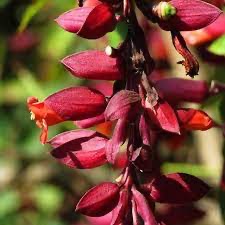
Habit
Shrub/Tree
Height
0.5 to 1.0 m
Growth
Moderate
Soil
Well-drained, Sandy Loam
Shade
Full Sun
Moisture
Moist
Edible
No
Medicinal
No
Origin
Africa
Climatic Condition
Tropical, Subtropical
Temperature (°)
20°C to 30°C
Humidity (%)
60% to 80%
Potting media
50% Loam, 40% Sand, 10% Organic Matter
Fertilizers
Organic Fertilizer
Watering
Regular watering
Plant Weight
0.2 to 0.3 kg
Flowering Time
Spring to Fall
Soil Ph level
6.0 to 7.5
Water Ph level
6.0 to 7.0
Soil EC
0.5 to 0.7 mS/cm
Yield Per Plant
1 to 2 kg per plant
NPK ratio
10:10:10
life Span
2 to 3 years
Health Benefits
Ornamental, Medicinal
Suggested Grow Media or Potting Mix ?
40% peat moss, 30% compost, 30% perlite
Suggested Fertigation/Fertilizers
Fertilize every 2 weeks with a balanced, water-soluble fertilizer.
Common Diseases and Remedies
Damping off , black leg .
black lesions , webby growth , coal black spots on leaves .
Avoid fungicides , rogue out plants , good sanitation .
HEALTH BENEFITS
1. Antioxidant properties: Thunbergia coccinea contains antioxidants that can help protect against oxidative stress and inflammation.
2. Anti-inflammatory effects: The plant's antioxidants and other compounds may help reduce inflammation and improve overall health.
3. May help improve cardiovascular health: Thunbergia coccinea antioxidants and other compounds may help improve cardiovascular health.
What is the Thunbergia coccinea plant?Thunbergia coccinea is a type of flowering plant in the fungus family. Commonly known as red clock vine or scarlet clock vine, it is native to tropical regions of Africa. This vine produces bright red-orange tubular flowers and is often grown as an ornamental plant in gardens and landscapes.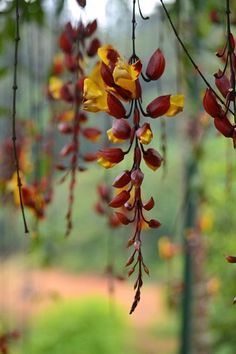
What types of Thunbergia coccinea plants are there?
Because Thunbergia coccinea is a type of plant, there are no different species, just as there are different varieties or cultivars of some plants. However, there may be differences in flower color and growth behavior within the same species, but these are not classified as separate types. The most common variation is the color of the flowers, the standard being red-orange, but shades of yellow and orange are also available.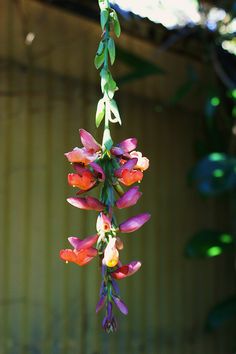
How do I care for my Thunbergia coccinea plant?
Location
Thunbergia coccinea plants grow in warm tropical climates. Requires full sun to part shade and well-drained soil. These plants are native to tropical areas of Africa and are usually grown outdoors in areas with mild winters. It can also be grown as an annual or brought indoors as a houseplant in colder climates.
Sunlight
Thunbergia coccinea plants prefer full sun to partial shade. Grows in an area that receives at least 6 hours of sunlight each day. However, it can tolerate some shade during the hottest parts of the day, especially in sunny areas.
Soil
Thunbergia coccinea plants prefer well-drained fertile soil. A well-drained, loamy soil mix is ideal for these plants. Additionally, adding organic matter such as compost to the soil can improve soil fertility and drainage, which can benefit Thunbergia coccinea growth. Avoid heavy or compacted soils that hold too much water, as this can cause root rot.
Hydration
Thunbergia coccinea plants require regular watering to keep the soil evenly moist but not waterlogged. Water the plant liberally whenever the soil surface feels dry. During hot, dry periods, more frequent watering may be necessary. However, it's essential to avoid overwatering, as this can lead to root rot. Additionally, providing a layer of mulch around the base of the plant can help retain moisture in the soil and regulate soil temperature.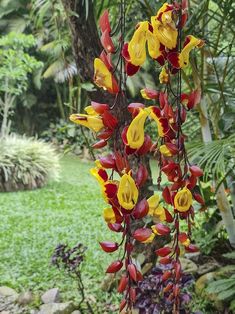
Nourishment
To keep Thunbergia coccinea plants healthy and thriving, it's beneficial to provide them with regular fertilization during the growing season. Use a balanced, water-soluble fertilizer formulated for flowering plants, and apply it according to the manufacturer's instructions. Fertilize the plants every 4-6 weeks during the growing season, typically from spring to early fall. Additionally, incorporating organic matter such as compost into the soil at planting time provides important nutrients and improves soil structure.
Issues
Thunbergia coccinea plants are relatively easy to care for, but some common problems can occur.
1. *Overwatering:* Too much water can cause root rot and other fungal diseases. It is important to let the soil dry out a little between watering to avoid waterlogging.
2. *Pests:* Aphids, spider mites, and whiteflies are common pests that can attack Thunbergia coccinea plants. Inspect plants regularly for signs of pest infestation and promptly treat with insecticidal soap or neem oil if necessary.
3. *Diseases:* Thunbergia coccinea plants may be susceptible to fungal diseases such as powdery mildew and leaf spot. To prevent the spread of disease, provide good air circulation around the plant, avoid overhead watering, and remove infected plant material.
4. *Nutritional deficiencies:* Lack of nutrients in the soil can lead to poor growth and reduced flowering. Nutrient deficiencies can be prevented by regularly applying a balanced fertilizer.
5. *Temperature Sensitivity:* Thunbergia coccinea plants are sensitive to low temperatures and can be damaged by exposure to frost or extended cold periods. Plant in a sheltered location to provide shelter during cold snaps if needed.
What are the benefits of Thunbergia coccinea plant?
Thunbergia coccinea plant has several benefits such as:
1. *Ornamental Value:* The bright red-orange tubular flowers add color and visual interest to gardens and landscapes, making it a popular ornamental plant.
2. *Attract pollinators:* Thunbergia coccinea flowers attract pollinators such as bees, butterflies, and hummingbirds, which help improve biodiversity and support local ecosystems
3. *Easy to care for:* These plants are relatively easy to care for and tolerate a variety of soil and light conditions, making them suitable for novice gardeners and those who don't have much time for gardening.
4. *Versatile:* Thunbergia coccinea can be grown as a hanging plant, vine, or even a ground cover, adding versatility to landscaping and garden design.
5. *Drought Tolerance:* Once established, Thunbergia coccinea plants have good drought tolerance and can survive dry periods with minimal water requirements.
Overall, Thunbergia coccinea plants offer beauty, biodiversity and ease of care, making them a valuable addition to gardens and landscapes.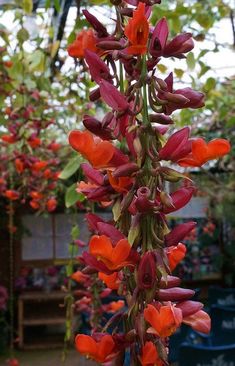
FAQ about growing Thunbergia coccinea plants
How to care for Thunbergia coccinea plants?
To care for your Thunbergia coccinea plant and keep it healthy and thriving, follow these care tips:
1. *Water:* Water the plant regularly and keep the soil evenly moist. Let it soak, but don't let it get soggy. Allow the top 1 inch of soil to dry slightly between waterings, especially during hot, dry weather. Avoid overwatering as this may cause root rot.
2. *Sunlight:* Place the plant in a location that receives at least 6 hours of sunlight per day, from full sun to partial shade. Be careful to avoid prolonged exposure to strong direct sunlight, especially in hot climates.
3. *Fertilization:* Fertilize Thunbergia coccinea plants every 4 to 6 weeks during the growing season with a balanced, water-soluble fertilizer intended for flowering plants. Follow the manufacturer's instructions for application amount.
4. *Pruning:* Pruning plants regularly to remove dead or diseased leaves, encourage bushier growth, and control size. You can also cut back the tips of the vines to encourage branching and produce more flowers.
5. *Support:* Support climbing varieties by installing a trellis, arbor, or other structure for the vines to climb. This prevents spreading and improves the decorative appearance.
6. *Mulching:* Apply a layer of organic mulch, such as compost or bark chips, around the base of plants to retain moisture in the soil, suppress weeds, and regulate soil temperature
7. *Pest and disease management:* Regularly monitor plants for signs of pests such as aphids, spider mites, whiteflies, and common diseases such as powdery mildew and spot. If an infestation or infection occurs, treat promptly with an appropriate insecticide or fungicide.
What is the Thunbergia coccinea plant used for?
1. *Ornamental Uses:* The bright red-orange tubular flowers of Thunbergia coccinea are a popular choice for ornamental gardens, landscapes, and containers. Their cascading or climbing habit adds beauty and visual interest to a variety of outdoor areas.
2. *Attract pollinators:* Thunbergia coccinea flowers attract pollinators such as bees, butterflies, and hummingbirds, improving biodiversity and supporting local ecosystems.
3. *Erosion Protection:* Thunbergia coccinea can be used to prevent erosion on slopes and banks due to its drooping and climbing growth habit. Dense foliage helps stabilize soil and prevent erosion.
4. *Ground Cover:* In suitable climates, Thunbergia coccinea can be used as a ground cover to fill in empty spaces and suppress weed growth. Its expansive growth and attractive foliage provide an effective ground cover solution.
Can I grow Thunbergia coccinea indoors?
Thunbergia coccinea plants are usually grown outdoors in warm tropical climates. However, it can be grown as a houseplant indoors in containers as long as certain conditions are met.
1. *Light:* Thunbergia coccinea plants require bright indirect sunlight to grow indoors. Place it near a south or west-facing window that receives at least six hours of sunlight per day. If natural light is not enough, additional artificial lighting can be used.
2. *Temperature:* Thunbergia coccinea prefers warm temperatures between 18 and 29 °C. Avoid placing it near drafty windows or in areas with temperature fluctuations, as this can stress the plant.
3. *Humidity:* These plants prefer medium to high humidity. To increase indoor humidity, you can use a humidifier, place a bowl of water and pebbles near the plant, or regularly mist the leaves.
Which pot is best for growing Thunbergia coccinea plants?
When choosing a pot to grow Thunbergia coccinea indoors, ensure proper drainage and enough space for the plant's roots to grow It is important to choose a pot that provides. Here are some considerations for choosing the best pot:1. *Size:* Choose a pot slightly larger than the plant's current root ball to allow for room for growth. However, avoid pots that are too large as they can hold too much water and cause the soil to become soggy.
2. *Material:* Choose pots made from breathable materials such as terracotta, clay, or ceramic. These materials evaporate excess moisture from the soil and provide aeration for plant roots
3. *Drainage Hole:* Make sure there is a drainage hole in the bottom of the pot so that excess water can drain out. This will prevent waterlogging and root rot.
Where can I buy Thunbergia coccinea?
Thunbergia coccinea plants can be purchased at a variety of locations including:
1. *Local Nursery:* Visit a local nursery or garden center near you. Especially during the growing season, it supports a variety of plants, including Thunbergia coccinea.
2. *Online Plant Retailers:* Many online retailers specialize in selling a wide range of plants, including Thunbergia coccinea. Websites like Etsy, Amazon, and specialty plant stores offer the convenience of shopping from home and often feature carefully selected plant varieties.

